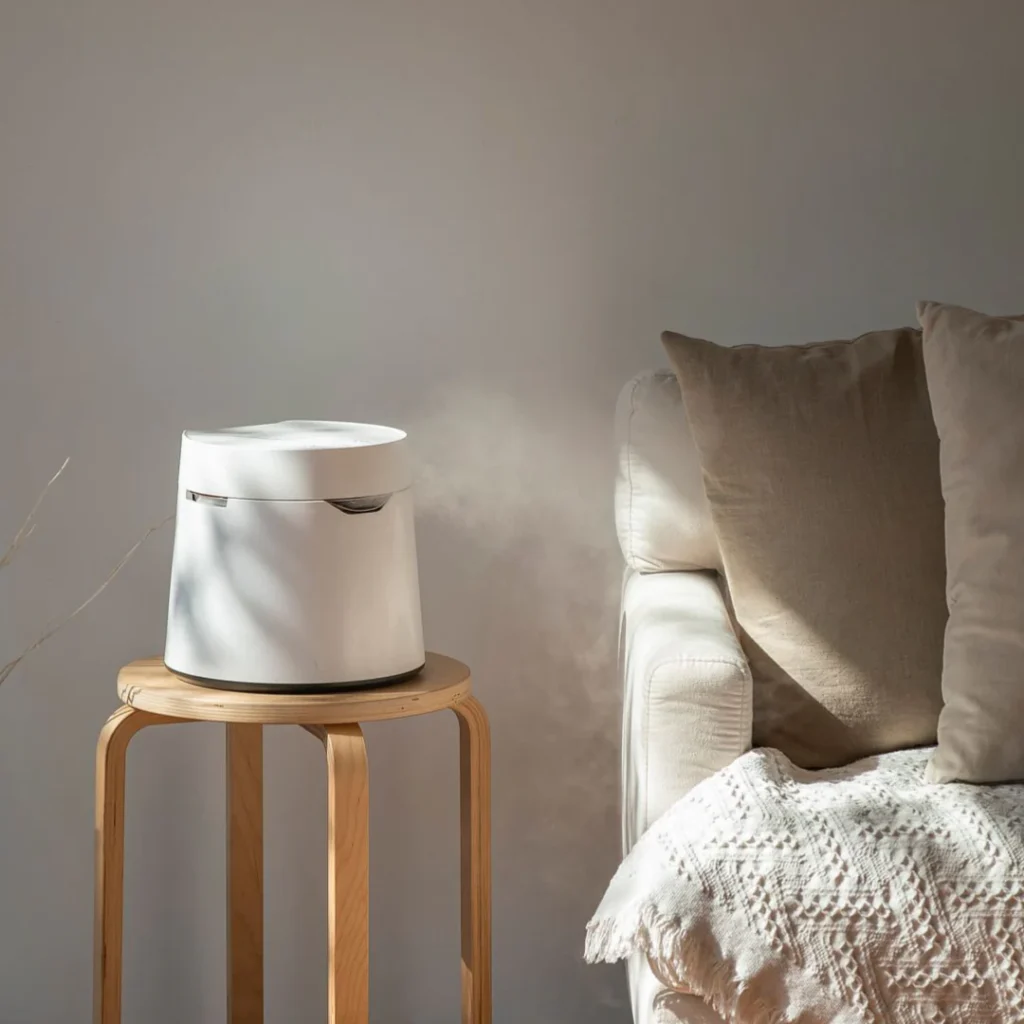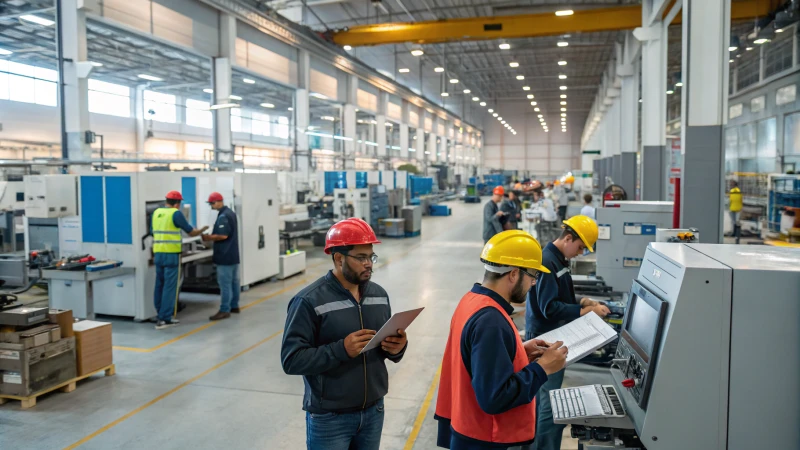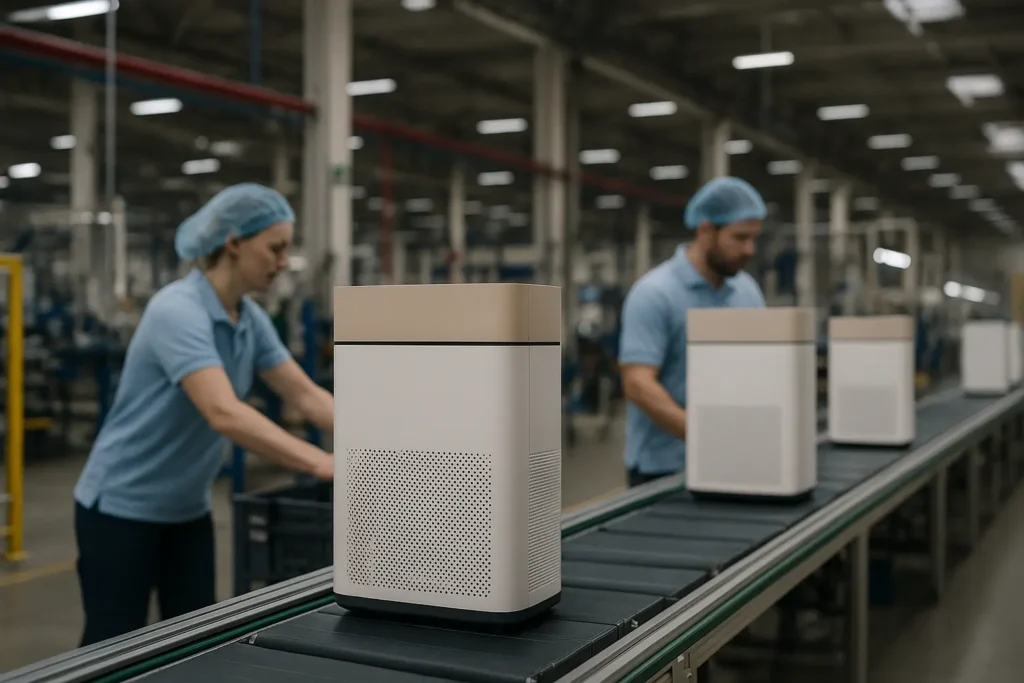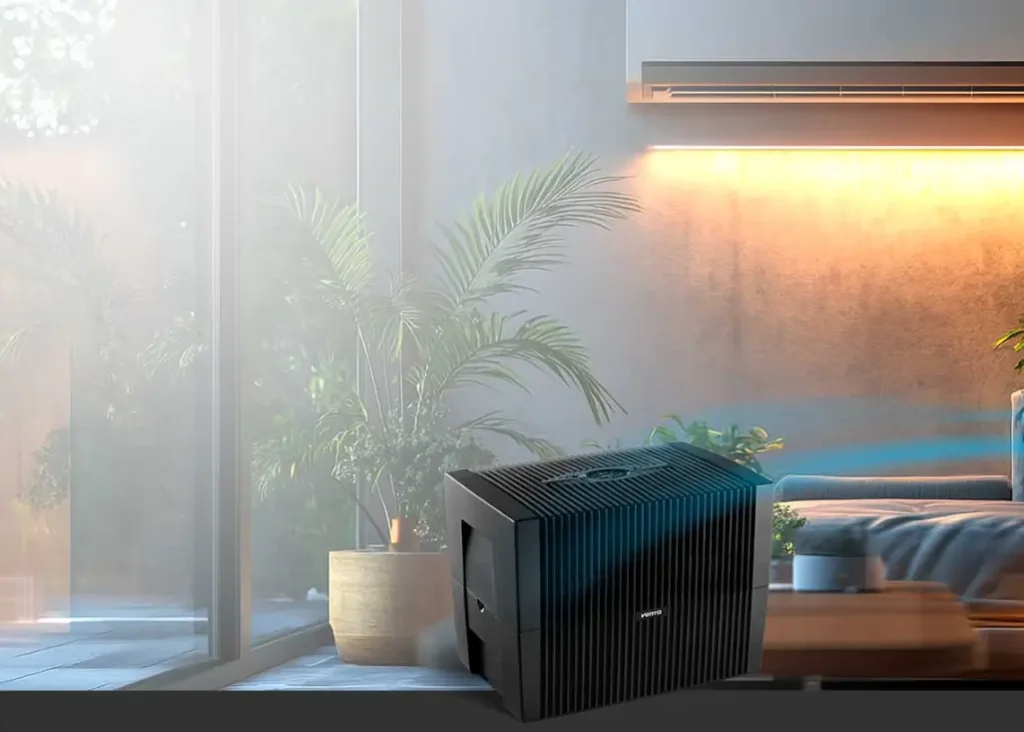Les filtres à air installés dans les appareils de CVC et les purificateurs d'air n'ont pas tous la même qualité ni la même fabrication. L'une des façons d'analyser ces filtres est d'utiliser l'indice MERV. Poursuivez votre lecture pour en savoir plus sur ce système.
Lorsque l'air se déplace et passe à travers les purificateurs d'air et d'autres systèmes CVC, il finit par passer par différents filtres. Dans le contexte des purificateurs d'air, les filtres retiennent les différents contaminants présents dans l'air, tels que les allergènes, la poussière et les agents pathogènes.
Mais tous les purificateurs d'air ne sont pas identiques. La plupart du temps, ils diffèrent par la qualité de leurs filtres. C'est là que vous aurez peut-être besoin d'apprendre quelle est la meilleure classification MERV pour les maisons et comment elle permet d'évaluer les performances des filtres à air.
Qu'est-ce que la classification des filtres MERV ?
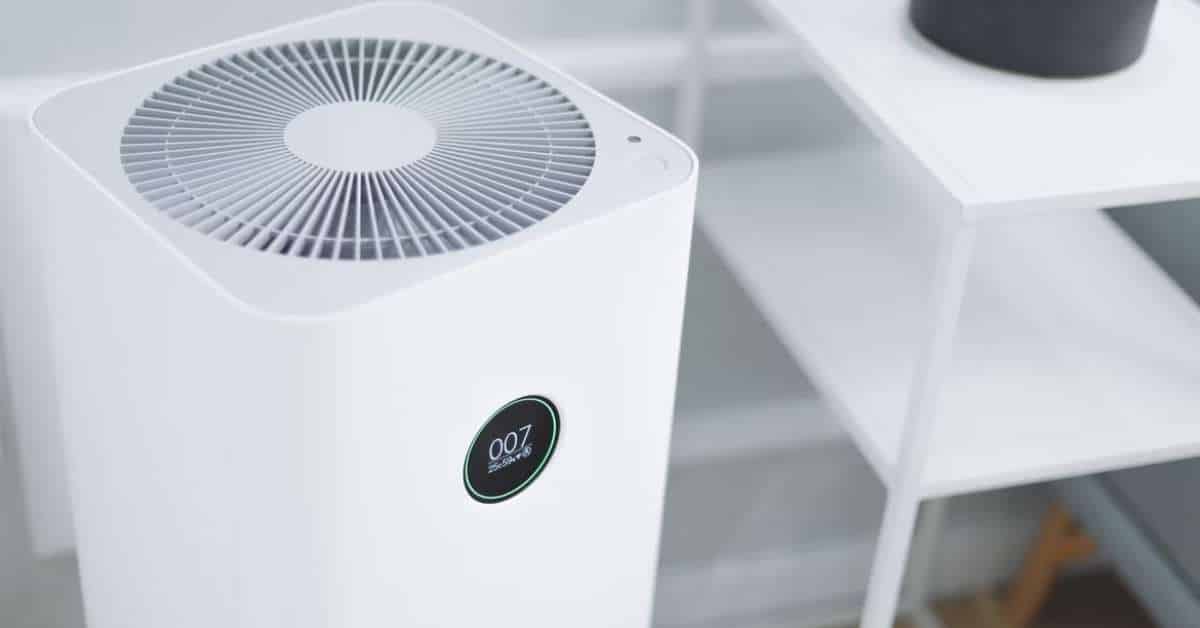
Source de l'image : Unsplash
Si vous êtes nouveau dans le monde des purificateurs d'air, il est probable que vous ne sachiez pas ce qu'est la classification MERV. Plus précisément, l'indice MERV correspond à l'indice Valeur minimale de la déclaration d'efficacité. Il s'agit d'une désignation attribuée aux filtres, et non aux purificateurs d'air complets.
En résumé, l'indice MERV des filtres domestiques indique l'efficacité d'un filtre particulier à capturer les différents contaminants en suspension dans l'air qui le traversent. Il est également à noter que les filtres ayant un indice MERV élevé sont réputés exceller dans la capture des petites particules.
Il est donc normal que les filtres HEPA aient l'indice MERV le plus élevé, étant donné qu'ils sont conçus pour piéger les particules et les substances microscopiques présentes dans l'air.
FPR, MERV & MPR : Quelles sont leurs différences ?
Les American Society of Heating, Refrigerating, and Air Conditioning Engineers (Société américaine des ingénieurs en chauffage, réfrigération et climatisation) (ASHRAE) a mis au point le système MERV. D'après les explications de l'ASHRAE, l'objectif du système MERV est d'aider les consommateurs à comprendre les performances de ces filtres et à trouver l'indice MERV idéal pour les habitations.
Cependant, ce n'est pas le seul système métrique d'évaluation des purificateurs d'air. Il existe encore le MPR et le FPR.
Signification et performance du filtre à air FPR
L'indice de performance des filtres (EPF) est une mesure de la capacité d'un purificateur d'air à éliminer les particules de l'air. Plus le FPR est élevé, plus le purificateur est capable d'éliminer les particules, sur une échelle de 4 à 10. Le FPR est basé sur la taille des particules que le purificateur peut éliminer, les plus petites étant les plus difficiles à éliminer. Cette mesure est effectuée par Home Depot.
Différence entre FPR et MERV
| Classement FPR pour les filtres | Équivalent du classement MERV | Types de polluants |
| 4 | MERV 8 - 10 | Poussière, peluches, acariens et moisissures |
| 5 | ||
| 6 | MERV 11 - 12 | Poussière, peluches, acariens, moisissures, squames d'animaux, fumée et smog |
| 7 | ||
| 8 | MERV 13 - 16 | Poussière, peluches, acariens, moisissures, squames d'animaux, fumée et smog, bactéries et virus |
| 9 | ||
| 10 |
Meilleure marque de filtre à air FPR
Il n'y a pas beaucoup de marques de filtres à air testés selon la norme FPR. Cependant, les purificateurs d'air vendus chez Home Depot sont équipés de filtres à air testés par le FPR. L'une de ces marques de filtres à air est Honeywell.
MPR
L'indice de performance des microparticules (MPR) est un moyen d'évaluer la capacité d'un filtre à air à éliminer les petites particules de l'air dont la taille est inférieure à 1 micron. Il s'agit d'un classement établi par 3M. Plus le MPR est élevé, meilleure est la capacité du filtre à éliminer les particules. Le système MPR évalue uniquement la capacité des filtres à éliminer les particules de 0,3 à 1 micron.
Différence entre FPR et MERV
| Les cotes MPR pour les filtres | Équivalent du classement MERV | Types de polluants |
| 300 | MERV 6 - 7 | Poussière et peluches |
| 600 | MERV 8 - 10 | Poussière, peluches, acariens et moisissures |
| 800 | ||
| 1000 | MERV 11 - 12 | Poussière, peluches, acariens, moisissures, squames d'animaux, fumée et smog |
| 1200 | ||
| 1500 | MERV 13 - 16 | Poussière, peluches, acariens, moisissures, squames d'animaux, fumée et smog, bactéries et virus |
| 1900 |
Meilleure marque de filtre à air FPR
L'indice FPR des filtres à air est important, tout comme l'indice MERV. Elle indique la capacité d'un filtre à air à éliminer les particules en suspension dans l'air. C'est pourquoi certaines marques de purificateurs d'air proposent des filtres certifiés selon ce critère. C'est le cas de la marque de purificateurs d'air Filtrete.
MERV
Comme nous l'avons mentionné, MERV est l'abréviation de Minimum Efficiency Reporting Value (valeur d'efficacité minimale rapportée). Plus précisément, il mesure la capacité du filtre à piéger les particules et les substances dont la taille est comprise entre 0,3 micron et 10 microns.
Il s'agit de la American Society of Heating, Refrigerating, and Air Conditioning Engineers (Société américaine des ingénieurs en chauffage, réfrigération et climatisation) (ASHRAE) qui a mis au point cette mesure. D'après les explications de l'ASHRAE, l'objectif de MERV est d'aider les consommateurs à comprendre les performances de ces filtres et à trouver l'indice MERV idéal pour les habitations.
Cote MERV pour les filtres : Pourquoi est-ce important ?

Source de l'image : Unsplash
Pourquoi est-il essentiel de parler de l'indice MERV ? La raison est la suivante :
COVID-19
Les filtres ayant un indice MERV élevé capturent efficacement le virus responsable de cette maladie potentiellement mortelle. Votre purificateur d'air doit être équipé d'un filtre de qualité médicale afin de réduire le risque de COVID-19 transmission à l'intérieur.
Selon l'ASHRAE, les filtres ayant un indice MERV de 13 conviennent pour COVID-19. Toutefois, il serait préférable de se procurer des filtres ayant un indice MERV de 14 ou plus, afin de garantir que l'air intérieur est à l'abri du COVID-19.
Incendies de forêt
Si vous résidez dans une région sujette aux incendies de forêt, vous devez donner la priorité aux systèmes d'épuration d'air qui ont un indice MERV élevé. Les incendies de forêt sont très dangereux, même si vous ne vous trouvez pas dans la ligne de mire. La fumée qu'ils génèrent contient des particules toxiques qui peuvent nuire à votre santé.
Efficacité énergétique
Les filtres à air qui obtiennent un score MERV élevé sont capables de réduire la présence de divers contaminants en suspension dans l'air, quelle que soit leur taille. Si votre purificateur d'air est équipé de ces filtres, la ventilation externe n'est peut-être plus nécessaire.
Si vous n'avez plus besoin d'ouvrir vos portes et fenêtres, cela se traduira par une meilleure consommation d'énergie. En effet, vous n'aurez plus besoin de recourir de manière excessive aux systèmes de refroidissement, de chauffage et autres systèmes CVC. Bien entendu, l'économie d'énergie est l'un des avantages d'un purificateur d'air performant.
Tableau d'évaluation MERV
N'oubliez jamais que le chiffre le plus élevé n'est pas forcément la meilleure solution pour vos problèmes d'air intérieur. Par exemple, si vous utilisez un filtre à air dont l'indice MERV est supérieur à celui qui est recommandé, les performances du purificateur d'air pourraient s'en trouver réduites.
À ce stade, il est déjà essentiel que vous preniez connaissance d'un tableau d'évaluation MERV authentique. Vous pouvez l'utiliser comme référence pour comprendre les filtres à air et leur utilisation appropriée.
| Norme 5.2 Valeur minimale de la déclaration d'efficacité | Efficacité des taches de poussière | Moyenne des arrêts | Contaminants couramment contrôlés | Utilisations et applications courantes | Type de filtre | Notations et utilisations spécifiques |
| 20
19 18 17 |
N/A
N/A N/A N/A |
N/A
N/A N/A N/A |
Particules <0,30 micron
Virus non attaché Poussière de carbone Tous les types de fumées de combustion |
Matières radioactives
Produits pharmaceutiques Matières cancérogènes Salles blanches |
Efficacité du filtre HEPA ≥99.999% pour les particules de .10 - .20 microns
Filtre HEPA ≥99.97% efficacité sur les particules de .30 microns |
Meilleur indice MERV pour la maison : MERV 8 - 13
Meilleur indice MERV pour le secteur résidentiel : MERV 8 - 10
Meilleur indice MERV pour la fumée des incendies de forêt : MERV 13 - 20
Meilleur indice MERV pour les allergies : MERV 16 - 20
Meilleur classement MERV pour la circulation de l'air : MERV 13 - 20
Meilleur indice MERV pour les squames d'animaux domestiques : MERV 11 - 16
Meilleur indice MERV pour la poussière de bois : MERV 11 -16
Meilleur indice MERV pour les spores de moisissures : MERV 17 - 20
Meilleur indice MERV pour les chaudières domestiques : MERV 6 - 8
Meilleur classement MERV pour un filtre de climatisation : Dépend de la compatibilité
Meilleur indice MERV pour les poussières de cloisons sèches : MERV 12 - 16
Meilleur indice MERV pour le pollen : MERV 16 - 20 |
| 16
15 14 13 |
N/A
>95% 90-95% 89-90% |
N/A
N/A >98% >98% |
.30-1.0 micron particules
Bactéries Fumée de tabac Noyaux de gouttelettes |
Bâtiments commerciaux
Salles de chirurgie Chambres d'hospitalisation Zones fumeurs et salons |
Filtre à manche
Filtre en boîte |
|
| 12
11 10 9 |
70-75%
60-65% 50-55% 40-45% |
>95%
>95% >95% >90% |
Particules de 1,0 à 3,0 microns
Poussière de plomb, poussière d'humidificateur Émissions automobiles, fumées, farine Fumée des incendies de forêt |
Bâtiments résidentiels
Bâtiments commerciaux Laboratoires hospitaliers |
Filtre à manche
Filtre en boîte |
|
| 8
7 6 5 |
30-35%
25-30% <20% <20% |
>90%
>90% 85-90% 85-90% |
Particules de 3,0 à 10,0 microns
Spores de moisissures, laque pour cheveux Protecteur de tissu, poussière de ciment Mélange pour pudding |
Bâtiments commerciaux
Bâtiments résidentiels Espaces industriels |
Filtres plissés
Filtres à cartouche Filtres jetables |
|
| 4
3 2 1 |
<20%
<20% <20% <20% |
75-80%
70-75% 65-70% <65% |
>10,0 microns
Pollen Acariens Poussière de peinture, poussière de ponçage Fibres de tapis et de textiles |
Zones nécessitant une filtration minimale de l'air
Résidentiel Climatiseurs de type fenêtre |
Cartouche
Jetable Électrostatique |
Échelle d'évaluation MERV
Il est important de comprendre les indices MERV. Elle vous permet de savoir quels filtres à air sont adaptés à vos besoins et à vos exigences. La purification de l'air étant un aspect vital de divers environnements intérieurs, il est essentiel que vous connaissiez les aspects techniques de la filtration.
Heureusement, il n'est pas difficile de comprendre l'évaluation. Après tout, elles ont été conçues pour que les consommateurs puissent analyser et comparer les différents filtres à air qui leur sont présentés.
Vous trouverez ci-dessous les lignes directrices spécifiques pour comprendre l'échelle d'évaluation MERV.
1-4 Valeurs MERV
- Dans cette catégorie, les filtres sont généralement utilisés pour les préfiltres, les climatiseurs de fenêtre et les chaudières résidentielles.
- Ils sont capables d'éliminer les gros pollens, les fibres de tapis et de textile, la sciure de bois et les acariens.
- La capacité réelle des filtres est de piéger des particules et des contaminants dont la taille ne dépasse pas 10 microns.
- Par ailleurs, ce classement n'est pas le meilleur choix pour les personnes souffrant d'allergies et d'asthme. Les filtres ne retiennent pas les substances allergisantes les plus courantes.
5-8 MERV
- À cette échelle, les filtres sont utilisés pour les bâtiments industriels, les structures résidentielles et commerciales et les cabines de peinture.
- Tant que vos systèmes CVC et vos purificateurs d'air sont équipés de ce filtre à air, vous pourrez réduire la sciure de bois, les fibres de tapis, le pollen, les acariens, la poussière de construction, les peluches et les spores de moisissure.
- Selon diverses références, les filtres MERV 5-8 sont capables de capturer des substances et des particules d'une taille comprise entre 3 et 10 microns.
- Il se peut que vous deviez dépenser un peu d'argent pour ces filtres.
9-12 MERV
- Lorsque le filtre est classé dans l'échelle MERV 9-12, cela signifie qu'il convient aux bâtiments résidentiels et commerciaux qui nécessitent une filtration de l'air plus poussée que la filtration conventionnelle. Les hôpitaux et les laboratoires en font partie. Votre maison peut également avoir besoin de ces filtres pendant la saison des incendies.
- Les filtres à air de cette catégorie sont capables d'atténuer la présence de fibres, de poussières domestiques, de légionelles, de poussières de plomb, de poussières d'humidificateur, d'acariens, de sciure de bois et de pollen.
- Ils peuvent filtrer des particules de 1 à 3 microns.
- Gardez à l'esprit que ces filtres sont légèrement plus chers que les filtres ayant un indice MERV inférieur.
13-16 MERV
- Si vous recherchez une filtration supérieure pour les bâtiments résidentiels et commerciaux, il est essentiel que vous achetiez des filtres appartenant à cette catégorie. Les filtres de cette échelle MERV sont généralement utilisés dans les établissements de soins, les salles d'opération et les hôpitaux. Techniquement, ils sont adaptés à la capture de polluants microscopiques.
- Fondamentalement, ces filtres sont capables de capturer tous les contaminants que les filtres MERV 1-12 peuvent éliminer.
- Mais ils conviennent également pour éliminer les agents pathogènes, les émissions des voitures, les particules d'éternuement, la fumée de tabac et de cigarette, les émanations, les résidus de produits cosmétiques et les squames d'animaux domestiques.
- La plupart des filtres HEPA appartiennent à cette catégorie. Ils peuvent capturer de 0,3 à 1 micron de particules et de substances dans l'air.
17-20 MERV
- Ces filtres sont utilisés dans les installations contenant des produits pharmaceutiques, des résidus cancérigènes et radioactifs, ainsi que dans les salles d'opération.
- Ils peuvent capturer toutes les particules, substances et polluants que les filtres MERV 1-16 peuvent éliminer. Mais ils peuvent également éliminer les virus, le radon, les allergènes microscopiques, la poussière de carbone et les résidus de combustion.
- Ces filtres sont capables d'éliminer les particules inférieures à 0,3 micron.
Tableau d'efficacité MERV
| Filtres à air | Filtre MERV 7 | Filtre MERV 8 | Filtre MERV 11 | Filtre MERV 13 | Filtre MERV 15 | Filtre MERV 16 | Filtre HEPA MERV 17 | Filtre HEPA MERV 18 | Filtre HEPA MERV 19 | Filtre HEPA MERV 20 |
| 0,3-1,0 microns | Sous 20% | Sous 20% | Sous 20% | Sous 75% | 85% - 94% | Au-dessus de 95% | 99.97% | 99.997% | 99.9997% | 99.99997% |
| 1,0-3,0 microns | Sous 20% | Sous 20% | 65% - 79% | Au-dessus de 90% | Au-dessus de 95% | Au-dessus de 95% | 99.99% | 99.99% | 99.99% | 99.99% |
| 3,0-10 microns | 50% - 69% | 70% - 85% | Au-dessus de 85% | Au-dessus de 90% | Au-dessus de 90% | Au-dessus de 90% | 99.99% | 99.99% | 99.99% | 99.99% |
Le tableau ci-dessus montre l'efficacité des filtres MERV à éliminer des particules de différentes tailles. Comme vous pouvez le constater, les indices MERV 16 à 20 offrent les capacités de filtration les plus élevées. Il s'agit essentiellement de filtres HEPA, qui peuvent donc capturer 99,9 % des contaminants en suspension dans l'air d'une taille de 0,1 micron. Ils sont parfaits pour les maisons et les espaces qui sont confrontés à des menaces constantes contre les allergènes et les agents pathogènes.
Meilleur classement MERV

Source de l'image : Unsplash
Les sections suivantes expliquent la classification MERV idéale pour des applications et des besoins spécifiques.
Meilleur classement MERV pour la maison
Pour votre maison, cela signifie que vous devez vous procurer des filtres ayant un indice MERV de 8 à 13. Plus précisément, il s'agit de filtres haut de gamme conçus pour des applications résidentielles et commerciales.
Meilleur classement MERV pour la fumée des incendies de forêt
Quel est donc l'indice MERV idéal pour la fumée des incendies de forêt ? D'après les recherches, un indice MERV de 9 à 12 est déjà la base pour absorber les menaces de la fumée des incendies de forêt. Mais si vous souhaitez des performances infaillibles, il est recommandé d'opter pour des filtres à air ayant un indice MERV de 13 à 20.
Meilleur indice MERV pour les allergies
Le filtre idéal pour les personnes souffrant d'allergies doit être capable d'éliminer les contaminants de 0,3 micron ou moins. Or, la plupart des allergènes courants se situent dans cette fourchette. Nous vous recommandons d'acheter des filtres à air MERV 17-20. Les filtres MERV 13-16 devraient faire l'affaire, mais il se peut que vous souhaitiez un degré de protection supplémentaire dans votre espace intérieur.
Meilleur classement MERV pour le débit d'air
Si vous souhaitez que votre espace dispose d'un flux d'air optimisé (sans menace de polluants en suspension dans l'air), vous devez vous procurer des filtres à air ayant un indice MERV 13 - 20. Dans cette fourchette, les filtres à air sont capables de capturer différents polluants présents dans l'air.
Meilleur classement MERV pour les squames d'animaux domestiques
Pour les squames d'animaux, il est préférable que votre purificateur d'air soit équipé de filtres ayant un indice MERV 11 - 16. Bien entendu, vous pouvez opter pour des filtres HEPA si vous souhaitez vous assurer que vous n'inhalerez pas de résidus d'animaux en suspension dans l'air.
Meilleur classement MERV pour la poussière de bois
La poussière de bois peut se présenter sous la forme de gros débris ou de poussière fine. Dans le premier cas, un indice MERV de 5 à 8 est déjà suffisant. En revanche, pour les poussières fines, vous avez besoin de filtres à air dont l'indice MERV est compris entre 11 et 16.
Meilleur indice MERV pour les spores de moisissures
Les spores de moisissures sont des allergènes microscopiques. Par conséquent, seuls les filtres HEPA sont efficaces contre eux. Les filtres à air de la gamme 17 - 20 sont les plus efficaces pour capturer les spores de moisissures.
Meilleure cote MERV pour une chaudière domestique
Pour les chaudières domestiques, les filtres à air ayant un indice MERV de 6 à 8 sont déjà acceptables. Mais si vous êtes préoccupé par les poussières fines, vous devriez opter pour des purificateurs d'air dotés de filtres HEPA.
Meilleur classement MERV pour un filtre de climatisation
Vous devez vérifier la compatibilité de votre système de climatisation avant de décider du type de filtre à air à installer. Plus l'indice MERV est élevé, plus le filtre est épais. Si le filtre est épais, il risque de ne pas s'adapter à votre appareil.
Meilleur indice MERV pour le pollen
Tout comme les spores de moisissures, le pollen est presque microscopique. Il est donc recommandé d'utiliser des filtres à air ayant un indice MERV de 17 à 20. Il s'agit essentiellement de filtres HEPA.
Meilleur classement MERV pour la poussière de cloison sèche
Vous pouvez vous procurer des filtres à air ayant un indice MERV de 13 à 16 afin de pouvoir traiter les poussières de cloisons sèches. Ils devraient suffire à éloigner ces résidus nocifs de votre système respiratoire.
Meilleur classement MERV pour les espaces résidentiels
Cela dépend du type de polluant auquel vous avez affaire. Normalement, un indice MERV de 8 à 13 devrait suffire. Mais si vous voulez être à l'abri des allergènes et des agents pathogènes, vous devriez obtenir filtres à air pour la maison avec un indice MERV de 17 à 20.
Filtre HEPA Cote MERV
Essentiellement, les filtres HEPA appartiennent à l'échelle supérieure de la classification MERV. Plus précisément, ils se situent dans l'échelle MERV 17 - 20. Ils sont capables de capturer au moins 99,9 % des contaminants microscopiques d'une taille aussi petite que 0,3 micron. Ils sont efficaces pour capturer les polluants tels que les agents pathogènes et les allergènes.
Meilleur purificateur d'air HEPA Classement MERV
Tous les filtres à air, quelle que soit leur marque, qui se situent dans la fourchette MERV de 17 à 20 sont déjà considérés comme des filtres HEPA. Si vous pouvez obtenir un filtre à air avec un indice MERV de 20, c'est une bonne chose. Cela signifie que le purificateur d'air peut éliminer les substances nocives pour les voies respiratoires présentes dans l'air.
Purificateur d'air Dyson Cote MERV
Dyson est une marque célèbre d'appareils de nettoyage domestique, tels que les aspirateurs. C'est également un fabricant réputé de purificateurs d'air HEPA. L'indice de ses filtres à air se situe entre 17 et 20. Vous pouvez donc être sûr que les purificateurs d'air Dyson éliminent efficacement les différents contaminants en suspension dans l'air.
Honeywell HPA300 Cote MERV
Le Honeywell HPA300 est un purificateur d'air remarquable. Il est équipé d'un filtre HEPA certifié Honeywell capable de capturer les particules microscopiques en suspension dans l'air, telles que les allergènes, les agents pathogènes et les poussières fines.
Cote MERV de GermGuardian
GermGuardian fabrique des purificateurs d'air de haute qualité pour les espaces résidentiels. Les filtres HEPA de ces purificateurs d'air sont au moins de niveau MERV 17. Cela prouve qu'ils sont aussi performants que d'autres marques de filtres à air.
Purificateurs d'air les plus performants avec classement HEPA
Voici d'autres marques de purificateurs d'air qui utilisent des filtres HEPA de haute qualité sur leurs produits.
Purificateurs d'air Mooka
Mooka est spécialisée dans la construction de purificateurs d'air résidentiels. En particulier, nombre de ses purificateurs d'air conviennent aux espaces de taille moyenne à grande. Comme prévu, ces purificateurs d'air sont dotés d'excellents filtres HEPA ; chacun de ces filtres a au moins un indice MERV 17.
Purificateurs d'air Colzer
Colzer propose une vaste sélection de purificateurs d'air HEPA. Quels que soient vos besoins en matière de purification de l'air intérieur, les purificateurs d'air Colzer peuvent y répondre. Selon leurs spécifications, le filtre HEPA moyen de Colzer a un indice MERV de 18.
Purificateurs d'air Bionaire
Bionaire utilise des filtres True HEPA sur ses purificateurs d'air, en plus des lampes UV. Ses filtres HEPA ont une cote d'au moins 18, il n'est donc pas surprenant que ses purificateurs d'air soient efficaces pour éliminer les polluants microscopiques.
Où sont fabriqués ces purificateurs d'air de marque ?
Les fabricants de purificateurs d'air ont tendance à construire leurs produits dans leurs installations respectives. Toutefois, un grand nombre d'entre eux choisissent d'externaliser la fabrication de leurs purificateurs d'air.
Plus précisément, ils préfèrent des pays comme la Chine en raison de sa production de haute qualité et de ses coûts de main-d'œuvre et de fabrication abordables. HisoAir fait partie des fournisseurs tiers de ces purificateurs d'air HEPA de marque.
Quel indice MERV devrais-je acheter ?
En matière d'indice MERV, il n'existe pas de solution unique. Vos besoins en matière de filtration de l'air peuvent être différents de ceux des autres utilisateurs, ce qui est tout à fait normal. Les espaces résidentiels situés dans une zone suburbaine ou rurale n'ont peut-être pas besoin d'une filtration de l'air aussi poussée que ceux situés en milieu urbain.
Cote MERV recommandée par Carrier
Transporteur a indiqué que l'indice MERV idéal pour les espaces résidentiels serait de 7 à 8. Pour les zones qui ont des besoins particuliers, il est préférable d'opter pour des purificateurs d'air dotés de filtres MERV 12 à 16. Bien entendu, la marque précise que les filtres HEPA offrent toujours les meilleurs résultats en matière de purification de l'air.
Cote MERV recommandée par Lennox
En attendant, Lennox a suggéré que la meilleure façon d'assainir l'air intérieur de votre bureau ou de votre maison est d'utiliser des purificateurs d'air de haute qualité. Plus précisément, Lennox a déclaré que les consommateurs devraient rechercher des purificateurs d'air équipés de filtres ayant un indice MERV d'au moins 10.
Cote MERV recommandée par Trane
Selon le Tranemais il est toujours essentiel de vérifier la compatibilité de vos systèmes CVC ou de vos purificateurs d'air lorsqu'il s'agit de choisir l'indice MERV idéal. La compatibilité est toujours un problème pour ces filtres, il est donc préférable de vérifier quels filtres sont compatibles avec vos purificateurs d'air.
Valeur MERV recommandée par Goodman
Goodman a indiqué que les filtres à air ayant un indice MERV de 7 à 13 sont déjà suffisants pour une utilisation domestique courante. Toutefois, cette entreprise de climatisation a précisé qu'il est essentiel de vérifier si votre système HVAC ou vos purificateurs d'air sont adaptés aux filtres que vous souhaitez obtenir.
Cote MERV recommandée par le CDC
Les Centres de contrôle et de prévention des maladies soulignent toujours l'importance de l'efficacité des purificateurs d'air. Il n'est donc pas surprenant que cette agence recommande l'utilisation de filtres à air ayant un indice MERV élevé. Plus l'indice est élevé, meilleure est la protection contre les agents pathogènes, tels que les virus.
Meilleur indice MERV pour différents types de microparticules
Les sections suivantes définissent les indices MERV idéaux pour des microparticules spécifiques. Il est essentiel que ces données soient correctes pour que vous puissiez trouver le filtre à air idéal pour les polluants atmosphériques problématiques, tels que allergène et des agents pathogènes.
Pour le pollen
Le pollen appartient à la classification MPR 1000 - 1200 microparticules. Mais certains pollens sont suffisamment gros pour être classés dans la catégorie MPR 300 - 600. Les filtres à air idéaux sont donc ceux qui ont un indice MERV de 9 à 12. Mais pour être sûr, choisissez des filtres à air ayant un indice MERV de 17 à 20.
Pour la fumée
Comme le pollen, la fumée de cigarette/tabac appartient à la catégorie MPR 1 000 - 1 200. Il est donc évident que les filtres ayant un indice MERV de 11 - 12 sont capables de traiter les particules liées à la fumée. Les filtres à air ayant un indice MERV de 13 et plus peuvent facilement traiter la fumée.
Pour la poussière
Les poussières peuvent être capturées par des filtres ayant un indice MERV d'au moins 6, ce qui équivaut à la classification MPR 300 - 500. Mais il faut bien sûr tenir compte du fait que certaines poussières sont déjà microscopiques. Il n'y a donc rien de mal à utiliser des filtres à air ayant un indice MERV de 16 ou plus.
Pour la fumée des incendies de forêt
Les filtres à haute efficacité (MERV 9 - 12) sont capables d'absorber les particules dangereuses contenues dans la fumée des incendies de forêt, selon l'Agence de protection de l'environnement. Les filtres True HEPA (MERV 17 et plus) peuvent quant à eux éliminer jusqu'à 99,9 % de ces polluants.
Pour les spores de moisissures
Les spores de moisissures appartiennent au moins au TPM 600. Mais certaines spores de moisissures sont classées jusqu'à 1 900 dans la classification MPR. Il convient donc d'opter pour de véritables filtres à haute efficacité ou pour des filtres qui se situent dans la fourchette MERV 17 - 20.
Conclusion
Il est évident que la qualité des filtres à air est essentielle à la performance globale des systèmes de CVC et d'épuration de l'air. Grâce à la classification MERV des filtres à air, vous serez en mesure de déterminer si un filtre particulier est adapté à vos besoins et à vos exigences.
Lorsqu'il s'agit de purifier l'air intérieur, les purificateurs d'air puissants et économes en énergie sont toujours le meilleur choix. Ces purificateurs d'air sont équipés de filtres capables de piéger les contaminants microscopiques présents dans l'air. Les purificateurs d'air HisoAir font partie des meilleures options pour ces filtres impeccables.
Visiter HisoAir et vérifier nos provisions.
Consultez d'autres blogs informatifs sur notre site !
- Se débarrasser de l'odeur de l'herbe : 5 méthodes éprouvées à essayer
- Comment enlever la poussière après des travaux de construction : 5 stratégies d'enlèvement faciles
- Comment se débarrasser des maux de tête dus aux allergies : 5 traitements efficaces



